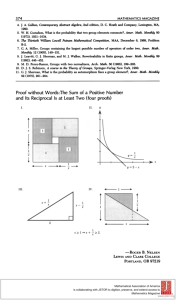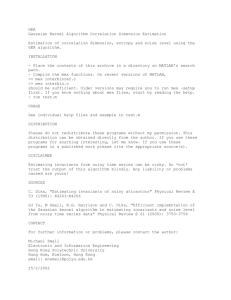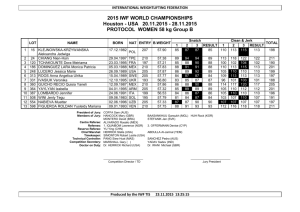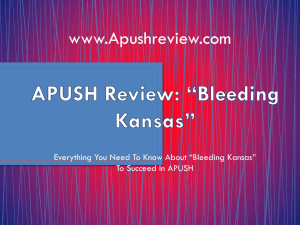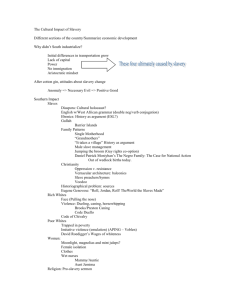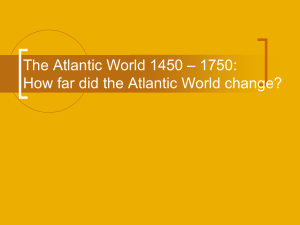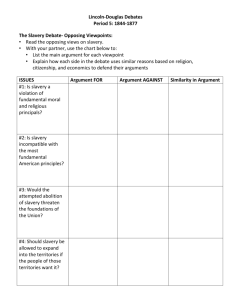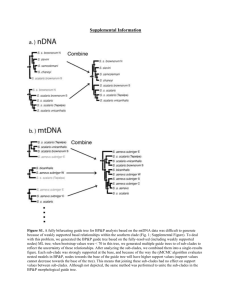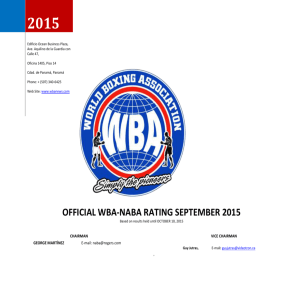Chapter 13 Key Terms
advertisement
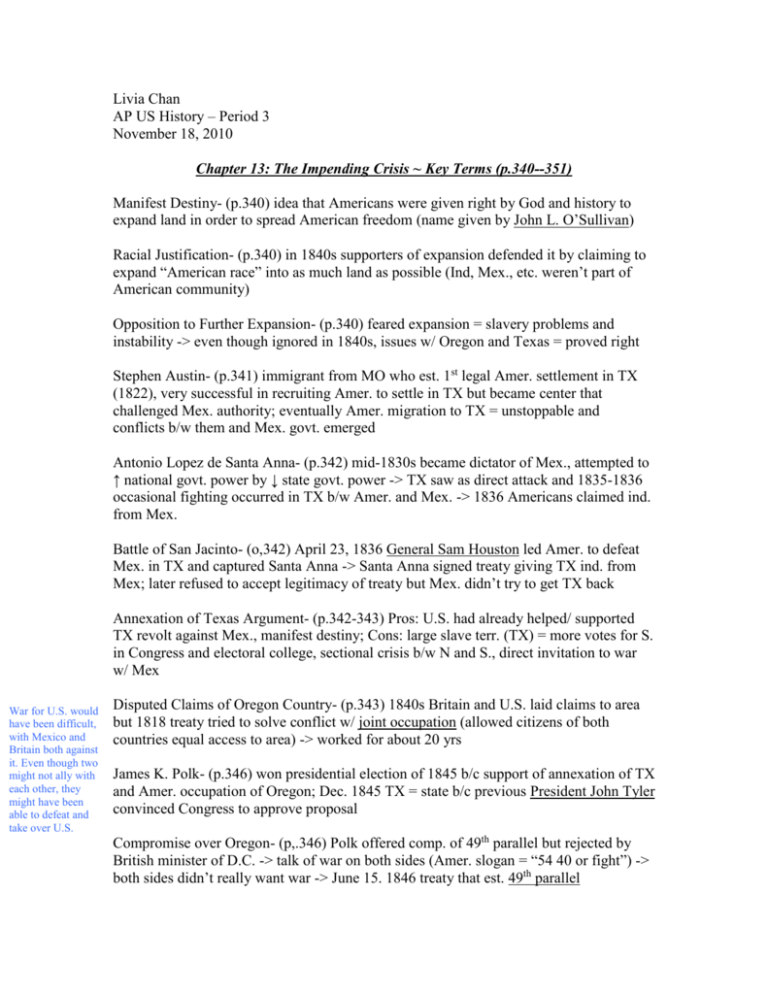
Livia Chan AP US History – Period 3 November 18, 2010 Chapter 13: The Impending Crisis ~ Key Terms (p.340--351) Manifest Destiny- (p.340) idea that Americans were given right by God and history to expand land in order to spread American freedom (name given by John L. O’Sullivan) Racial Justification- (p.340) in 1840s supporters of expansion defended it by claiming to expand “American race” into as much land as possible (Ind, Mex., etc. weren’t part of American community) Opposition to Further Expansion- (p.340) feared expansion = slavery problems and instability -> even though ignored in 1840s, issues w/ Oregon and Texas = proved right Stephen Austin- (p.341) immigrant from MO who est. 1st legal Amer. settlement in TX (1822), very successful in recruiting Amer. to settle in TX but became center that challenged Mex. authority; eventually Amer. migration to TX = unstoppable and conflicts b/w them and Mex. govt. emerged Antonio Lopez de Santa Anna- (p.342) mid-1830s became dictator of Mex., attempted to ↑ national govt. power by ↓ state govt. power -> TX saw as direct attack and 1835-1836 occasional fighting occurred in TX b/w Amer. and Mex. -> 1836 Americans claimed ind. from Mex. Battle of San Jacinto- (o,342) April 23, 1836 General Sam Houston led Amer. to defeat Mex. in TX and captured Santa Anna -> Santa Anna signed treaty giving TX ind. from Mex; later refused to accept legitimacy of treaty but Mex. didn’t try to get TX back Annexation of Texas Argument- (p.342-343) Pros: U.S. had already helped/ supported TX revolt against Mex., manifest destiny; Cons: large slave terr. (TX) = more votes for S. in Congress and electoral college, sectional crisis b/w N and S., direct invitation to war w/ Mex War for U.S. would have been difficult, with Mexico and Britain both against it. Even though two might not ally with each other, they might have been able to defeat and take over U.S. Disputed Claims of Oregon Country- (p.343) 1840s Britain and U.S. laid claims to area but 1818 treaty tried to solve conflict w/ joint occupation (allowed citizens of both countries equal access to area) -> worked for about 20 yrs James K. Polk- (p.346) won presidential election of 1845 b/c support of annexation of TX and Amer. occupation of Oregon; Dec. 1845 TX = state b/c previous President John Tyler convinced Congress to approve proposal Compromise over Oregon- (p,.346) Polk offered comp. of 49th parallel but rejected by British minister of D.C. -> talk of war on both sides (Amer. slogan = “54 40 or fight”) -> both sides didn’t really want war -> June 15. 1846 treaty that est. 49th parallel Failure of Slidell Mission- (p.347) Polk sent John Slidell to offer to buy CA and TX terr. -> MX refused -> war declared on MX on May 13, 1846 Bear Flag Revolution- (p.348) Colonel Stephen W. Kearny took Amer. forces (Amer. settlers, armed exploring party led by John C. Frémont, and Amer. navy) under command and conquered CA for U.S. Treaty of Guadalupe Hidalgo- (p.348) Feb. 2, 1848 Nicholas Trist (U.S. rep to MX) made treaty w/ MX that gave CA and New MX to U.S. and acknowledged Rio Grande as the boundary b/w TX and MX, in return U.S. paid MX $15 million and responsible for new citizens’ financial debts to Mex. November 19, 2010 Chapter 13: The Impending Crisis ~ Key Terms (p.351-364) Wilmot Proviso- (p.351) 1846 amendment proposed by David Wilmot (PA); addition to bill where Polk asked Congress to use $2 million to buy peace w/ MX (before war was over), was not passed but cont. to be debated years after Many of the fortyniners went to CA in search of gold but in the end found far less than was expected. The dramatic increase in migration helped establish CA terr. as an Amer. dominated area. Competing Plans- (p.351) diff. proposals were created to satisfy sectional conflict w/ slavery: Polk proposed extending MO Comp. Line to new terr. and others supported popular sovereignty; neither proposal won over even by 1849 Election of 1848- (p.351) Democrats = Lewis Cass (MI), Whigs = General Zachary Taylor (LA), Free-Soil Party = Martin Van Buren; Taylor won Free-Soil Party- (p.351) emerged during election of 1848 when antislavery supporters didn’t like any of the candidates; members consisted of Liberty Party, antislavery people from Whig/Democratic Parties and supporters of Wilmot Proviso; even though lost election, emerged as substantial political party and showed instability of 2nd party system Forty-niners- (p.351) migrants to CA during gold rush, didn’t take caution and time to prepare, simply abandoned lives in hope of striking rich, 95% were men and society wasn’t as solid w/out women, children, families Transcontinental Railroad and Slavery- (p.356) problem was where RR would connect to east: free states wanted Chicago (located in N.), slave states wanted St. Louis, Memphis, or New Orleans (in S.); RR became another conflict w/ N and S Gadsden Purchase- (p.356) 1853 James Gadsden sent to buy land from MS for $10 million by U.S.; purchase allowed RR to be built to S. from W. and intensified RR debate Brooks and Sumner incident showed that violence over Kansas was not limited to only the area. Congress had violence too -> showed how violence would lead to war b/w two groups Kansas-Nebraska Act- (p.356) 1854 proposed by Stephen Douglas, Kansas and Nebraska Terr. = popular sovereignty for slavery and MO Comp. repealed Whig Party split and destroyed, 1854 Republican Party formed by people who opposed Act Pottawatomie Massacre- (p.357) John Brown and 6 followers murdered 5 pro-slavery settlers in Kansas, tried to convince others to stay away; guerilla warfare occurred b/w 2 groups -> “Bleeding Kansas” Preston Brooks and Charles Sumner- (p.357) Brooks beat Sumner w/ cane b/c Sumner insulted his uncle; Brooks = hero in South while Sumner = hero too in North b/c served as icon of barbaric violence of South “Free Soil” Ideology- (p.357-358) not all believed slavery = morally wrong and new free soil idea emerged b/c whites feared limiting blacks’ rights/ opportunities reflected what white society could become -> contradicted idea of Amer. capitalism -> South = “slave power conspiracy”; Southerners were said to destroy capitalism through slavery in order to create aristocratic system -> helped Republican Party gain power b/c idea of destroying idealized nation = unthinkable The Pro-Slavery Argument- (p.359) idea began w/ Professor Thomas R. Dew in 1832 -> turned into an anthology by others that gave ideology its name; slavery was good for slaves, south, and nation: slaves = in better conditions than industrial workers in N. and needed paternal supervision of whites, only way for blacks and whites to coexist peacefully, helped S. prosper = helped nation as whole prosper, provided South w/ stable and ordered society unlike North; used churches to justify slavery Election of 1856- (p.359) Democrats = James Buchanan (PA) b/c was away during recent controversies and therefore unassociated (not blamed), Republicans = John C. Frémont b/c was famous as explorer but had no political record (safe candidate), Know-Nothings = Millard Fillmore (ex-President); Buchanan won but was very quiet and indecisive -> depression soon after was blamed on him and Republicans gained in power despite loss in elections The Dred Scott Decision- (p.360-361) Roger B. Taney ruled that Scott = black = not citizen = couldn’t sue, Scott = slave = property = Congress couldn’t do anything about taking him away from Sanford, MO Comp. = unconstitutional; Southerners were delighted w/ decision but N. = appalled that fed. govt. was unable to interfere Lecompton Constitution- (p.362) created by pro-slavery legis. of Kansas for statehood but wasn’t put to vote b/c knew would be rejected -> later put to vote and rejected -> showed majority of Kansas opposed slavery -> 1861 Kansas = free state Abraham Lincoln- (p.362-363) lost against Stephen Douglass for Senate but became more widely known through Lincoln-Douglas Debates; thought slavery = morally wrong but ≠ abolitionist b/c couldn’t’ think of alternative to slavery Brown’s revolt idea probably didn’t work out b/c some slaves were content w/ life or were to afraid to revolt. Others thought not to risk it just in case became only one and was severely punished/ sentenced to death. John Brown’s Raid- (p.363) 1859 Brown and followers sized U.S. arsenal in Harpers Ferry, VA b/c hoped to inspire slave revolt -> revolt didn’t happen and U.S. troops captured rebels and hung them; made Southerners convinced that Republican Party + North = completely against them and began to consider seceding Union Election of 1860- (p.363-364) Democrats divided and had 2 diff. candidates = Stephen Douglas and John C Breckinridge, Ex-Whigs formed Constitutional Union Party = John Bell -> no position of slavery, Republicans = Abraham Lincoln; Lincoln won and Southern states seceded, believing w/ Lincoln as pres, slavery = certain to be abolished
